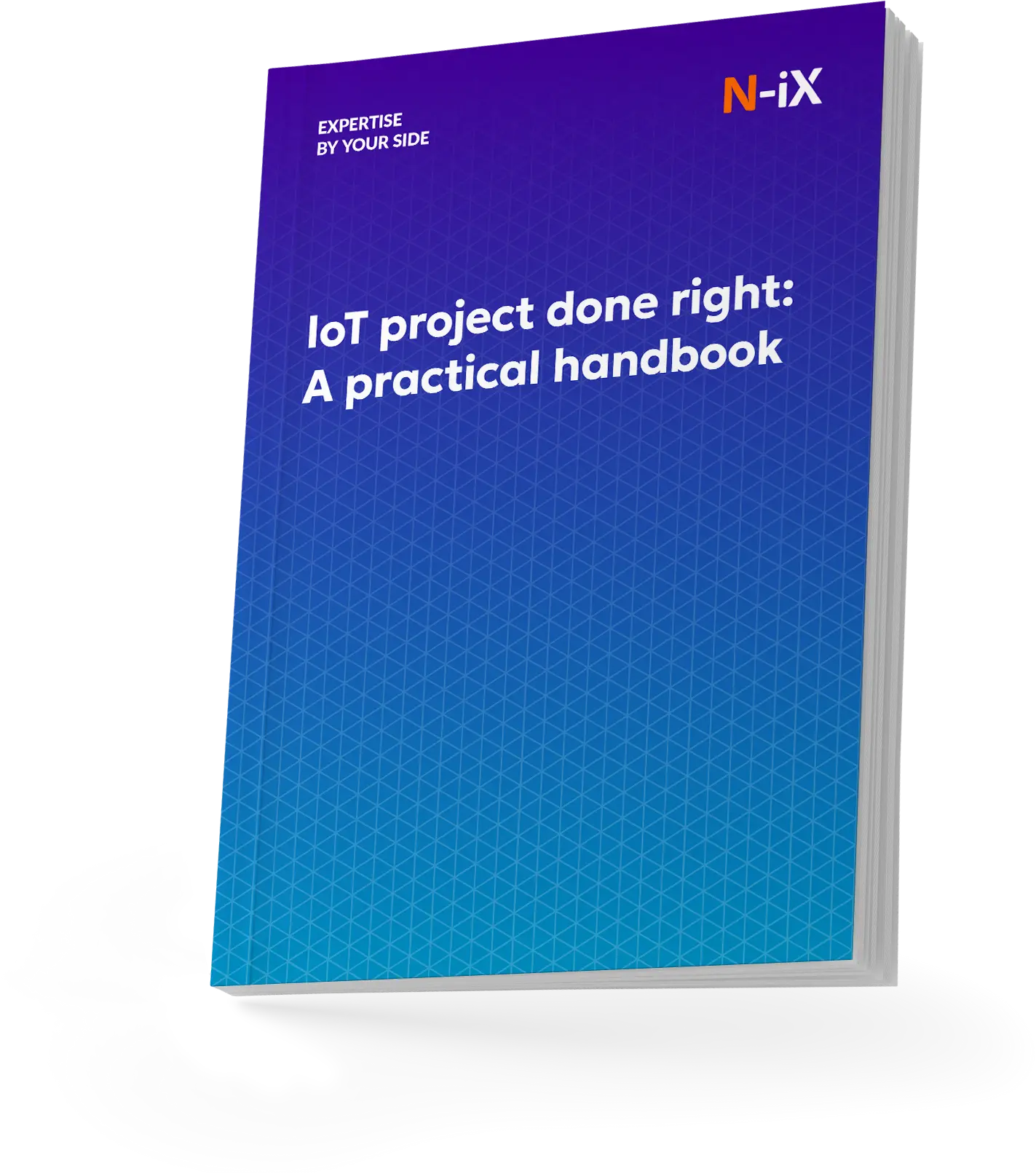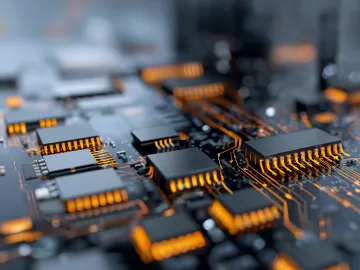Embedded software is becoming omnipresent in both consumer and industrial sectors. Almost every modern device comes with an embedded software system. Global Market Insights estimate that the embedded software market will reach $40B by 2032.
One of the main reasons for the increased adoption of embedded technologies is their use by electronics, manufacturing, logistics, and automotive companies for increased functionality, improved quality, better control over resources and equipment, and reusability. However, the complexity in this field and ever-changing technology trends in embedded software are increasing development costs. That’s why companies explore the opportunity of outsourcing embedded software projects to cut costs while improving quality and time to market.
At N-iX, we have been providing embedded software services for over a decade and understand how challenging it might be to find qualified engineers to match your tech needs. Let’s explore tips to help you drive the maximum value from your embedded software project.
1. Examine the expertise and experience of your embedded software outsourcing provider
A reliable embedded software outsourcing company should have a solid portfolio of successful projects and profound expertise in developing software and hardware for complex embedded systems. Embedded engineers should be able to cover all aspects of development, including product discovery, software development, quality assurance, product launch, provisioning, commissioning, and, most importantly - certification. Also, your tech partner’s embedded team should possess a solid number of experts working on your project. The reason behind this requirement is the potential scaling and further development of a custom-embedded solution.
An embedded software development company with the right technical expertise and experience working across multiple industries will likely offer transformative solutions and drive innovation on your project. N-iX provides various embedded outsourcing services, including firmware & hardware development, products SDK development and maintenance, integration with third-party technologies, installation support, product certification, maintenance, and continuous integration. At N-iX, we develop embedded solutions for industrial automation and the consumer electronics industry.
- Our recent projects include embedded Linux firmware development for Weinmann Emergency, a Germany-based company that develops mobile medical devices for emergency vehicles, helicopters, and airplanes.
- Also, we partnered with a Swedish company Anoto to help them develop an embedded solution that transforms handwritten notes and drawings into digital data.
- Locinox, a Belgian company that develops high-quality mechanical and electro-mechanical components for fences and gates, is also among our clients. N-iX embedded engineers have been collaborating with them on developing devices that ensure the safe opening of gates through access codes and provide easy and controlled access to the premises.
Besides a portfolio of successfully delivered projects, N-iX has established a partnership with Nordic Semiconductor, a leader in wireless connectivity for IoT systems. Nordic Semiconductor is a Norwegian fabless company specializing in developing wireless communication technology that powers IoT solutions. N-iX has been implementing Nordic-powered products for years, and the newly formed partnership serves as a natural next step in long-time cooperation.
2. Define the skills your remote embedded team needs to have
The technological toolkit, or tech stack, that an embedded software engineer utilizes can differ significantly based on several factors. These primarily include the intricacy of the product being developed and the specific requirements set for the project. Nonetheless, certain skills and experiences remain universally necessary across all embedded projects.
Experience with General-Purpose Operating Systems (GPOS) and Real-Time Operating Systems (RTOS) stands out among these critical skills. These operating systems form the backbone of most embedded projects, with the GPOS providing a flexible and versatile platform for software development and the RTOS ensuring the timely and accurate execution of tasks, which is a critical factor in embedded systems.
Another essential skill for an embedded engineer is proficiency in programming languages, notably C and C++. These languages are often the foundation of embedded development due to their efficiency, direct access to hardware resources, and control over system components. Project specifications sometimes require knowledge of other programming languages such as Java, .NET, and Python.
An embedded engineer's role goes beyond programming language proficiency. These specialists must also demonstrate a solid grasp of theoretical and abstract concepts. They include algorithms, design patterns, and data structures, which organize and store information. Understanding control systems is crucial, as these often form the core of the embedded systems, responsible for controlling the interaction between various components.
A qualified embedded developer should also be familiar with networking technologies. It includes Ethernet, the standard for wired networks, and TCP/IP, the suite of communication protocols used on the Internet. This knowledge is necessary to facilitate communication between the embedded system and other devices or systems.
Finally, an embedded outsourcing specialist needs a robust understanding of computer hardware, including different types of memory like RAM (Random Access Memory), ROM (Read-Only Memory), and Flash memory, each with unique characteristics and uses. Knowledge of microprocessor and microcontroller architectures is also critical, as these components are often the heart of an embedded system. Familiarity with different protocols, which set the rules for data exchange between systems, rounds out the necessary competencies for an embedded engineer.

An established embedded projects outsourcing provider should be able to gather a remote embedded team within a reasonable time with the skills and tech expertise necessary to implement the client’s project.
Related: Embedded system engineering: How to do it right?
3. Team up with a development partner that has a solid understanding of hardware capabilities
The primary responsibility of an embedded software engineering team revolves around harnessing the full potential of hardware components to enhance the benefits for the end user. Embedded engineers must comprehensively understand the hardware they are working with. Embedded projects often have varying requirements regarding computing or data processing power, memory size, and HDD or SSD capacity.
These requirements can differ significantly based on the application and the environment in which these systems are deployed. Embedded engineers should provide ideal configurations, considering several elements such as form factors, central processing units (CPU), memory, storage, and input/output systems (I/Os).
Choosing a technology partner for embedded projects is more than just assembling a team with expertise in embedded computing solutions. Your tech partner should also be up-to-date with the latest advancements in processor technologies to deliver innovative solutions to complex projects.
Approach your IoT project avoiding major risks—get the guide!


Success!

4. Use Agile development strategies to maximize project efficiency
Project management in the tech industry often grapples with common issues such as extended development cycles, delayed delivery, unpredictable timelines, subpar quality, and the burnout of engineers. One approach to circumvent these challenges, particularly in the realm of embedded software development, is the adoption of Agile methodologies. These practices can significantly accelerate the product development lifecycle and help teams overcome the inherent constraints associated with this field. However, the successful implementation of Agile for combined hardware and software development can sometimes require external guidance.
To establish an efficient Agile-based operating model, the team's methodology, structure, size, tools, practices, and metrics. These elements can be established by creating a baseline map of the existing environment and product architecture. Milestone-driven release plans can involve Agile methodologies in a hardware development environment.

Given the necessity of system testing in most embedded environments, it's crucial to incorporate these testing activities within Agile cycles. It would involve dedicated testing teams performing regular and iterative functional, scalability, and system-level testing.
An additional strategy involves progressively decoupling the product architecture. This move enhances the team's ability to swiftly modify, construct, and test individual architectural layers or specific product components. Consequently, this approach leads to the consistent achievement of program performance targets and enables the delivery of products at the desired speed. It also brings benefits such as early customer engagement, continuous testing, and early program risk visibility. Whether your project is hardware/software-focused or hybrid, introducing Agile practices to your development processes is an effective strategy.
5. Don’t underestimate the flexibility factor
When partnering with an embedded software outsourcing provider, securing the services of embedded engineers who demonstrate adaptability. The nature of embedded development often necessitates engineers to acquire diverse skills tailored to specific hardware attributes. For instance, they might be required to develop a proof-of-concept prototype in an unfamiliar language within a few weeks or promptly dive into an existing legacy project to rectify a bug. A solid understanding of software architecture concepts, event-driven systems, and modeling (UML) is crucial. Coupling this knowledge with the agility to learn new concepts and adapt rapidly can significantly enhance the development of quality firmware and hardware from scratch.
Another critical factor to consider is the outsourcing provider's capacity to adjust the size of the team of embedded engineers swiftly. For rapidly growing businesses, scaling up or down the team in minimal time frames is essential. Depending on the tech stack and the availability of tech talent in the local market, the notice period for expanding or reducing a team with a single embedded engineer can vary from 1 to 3 months. Therefore, it is crucial to negotiate and agree upon reasonable notice periods with the vendor in the contract to ensure efficient and effective project execution.

The success story of enhancing an embedded software solution
After learning about the five fundamental rules of outsourcing embedded software projects, it’s also wise to learn from the stories of successful integrations of embedded solutions. One example of our team at N-iX was cooperation with an Australian client, a leader in building intelligent parking solutions, seeking to enhance their embedded solutions' efficiency and improve user experience. They aimed to modernize their secure storage product and develop a new version of the parking meter.
Through a partnership with N-iX, the company could enhance its services by redesigning the original parking meter for the Malaysian market and initiating its development for other markets. The modernization included improving UI design, microservices, and security and developing a solar-powered, next-generation parking meter.
The new meter features a touchscreen, energy-efficient solar power, and 3G connectivity for balance and parking time checks. The legacy safe cabinet was also upgraded to be touchscreen compatible. N-iX's contributions improved the client's service quality, boosted the parking meter's operational efficiency, and facilitated market growth.
Value delivered by the N-iX Embedded team:
- Improving the quality of provided services by modernizing the legacy security storage product;
- Boost operational efficiency of the new parking meter by optimizing solar energy consumption;
- Facilitate market growth by developing a new parking meter for the Malaysian market.
Keep reading: Enhancing embedded solutions for vehicle parking and safe storage
Wrapping up
Outsourcing embedded software development brings many advantages, including access to top-tier talent, enhanced project scalability, and a more predictable financial outcome. However, the triumph of an outsourced embedded software project hinges heavily on the aptitudes, experience, and knowledge of the embedded engineers you opt to collaborate with. As such, paying attention to these basic principles of outsourcing embedded software projects when searching for a remote embedded team is essential. These guidelines will equip you to proficiently manage challenges at each product development phase and elevate your business to new heights.
Read more: 10 challenges of embedded project development and ways to address them
Reasons to select N-iX as your bespoke embedded software development partner
- Comprehensive support throughout hardware and software development, from product discovery and design to development, manufacturing, validation, and installation assistance;
- One-stop-shop strategy for embedded project development, providing cost and time optimization. We will conduct the Discovery Phase, design and develop your embedded system, test its quality, help you pass the necessary certifications, support the installation process, and maintain your system up and running;
- Utilization of Agile methodology by our software and hardware developers for creating new products, enhancing existing ones, or revamping legacy systems to boost performance;
- Adherence to global industry and security standards such as ISO 27001:2013, PCI DSS, ISO 9001:2015, GDPR, and HIPAA, ensuring the protection of your sensitive information;
- Established legal presence in the United States, with over one-third of our clientele originating from North American companies.
Have a question?
Speak to an expert





